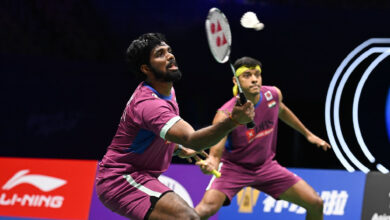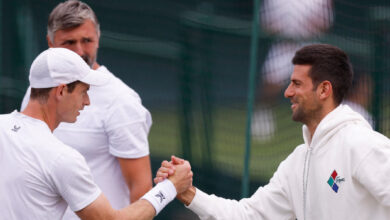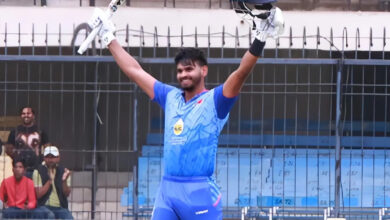Indonesia Open: How Lakshya Sen’s well-honed defence came to the fore in quarterfinal win against world No 12 Nishimoto | Badminton News

Tasked with keeping his ward Lakshya Sen’s feet on the ground even as the Indonesian fans went hysterical over some of his stunning reflex shots, coach Vimal Kumar scythes the hype. “It’s not his trademark shot or anything,” he says, dismissing the spectacular body defense stroke that Sen hit against Kenta Nishimoto on 11-8 in the second set. It was the shot that deflated the Japanese completely as he went down 21-9, 21-15 in the pre-quarterfinals of the Indonesia Open Super 1000 in Jakarta.Vimal, the hard taskmaster, was quick to point out that the “real test” was in Friday’s quarters against Anders Antonsen. Father and co-coach DK Sen would gush and call it one of those things that Sen gets right when he’s in the flow. Both knew however that the gritty Nishimoto’s back was broken after that defensive dazzle.
Nishimoto is World No 12 and known for grinding out wins. He had lost the opener 21-9, but was looking good to regroup in the second as he picked 5 points in a row upping the pace and hitting the lines to Sen’s forehand that always has the Indian in trouble, going up 8-6. It’s here that Sen got into the flow, where his reflex defense gets so outlandish that opponents wilt as the shuttle gets unbelievably returned.
Renowned commentator Gill Clark had just been wagering her Earl Grey cuppa over a line call the previous point, as the match margins were beginning to get tight. At 10-8, the duo got into a fast-paced rally and the Japanese sent a charging smash most awkwardly on Sen’s torso, close to where the elbow of the racquet holding hand usually is. The Indian not only anticipated it, but swivelled a tad to the left instinct and made just enough room for a wry backhand reflex return. And it travelled.
Nishimoto had looked sure he was closing in at 9-10. But the shuttle shot out from a near-irretrievable placement as if catapulted from a very tight corner, then bulleted to the half court and gave the Indian an outrageous winner and a neat 11-8 lead. In that break, Nishimoto got needless time to mull over that ‘what – just – happened’ shot, and he played like he’d seen a ghost thereafter.
The Japanese had a plan to push Sen to the back court and keep him away from the net. At 17-12 he even got a body smash point, because he had pushed Sen further down to the baseline from where a reflex flick cannot travel over the net. But while playing flat, and in Sen’s stomping area from net to mid-court, Nishimoto just could not stop dreading that Sen could pull off one of his ridiculous defensive winners. It ended as an efficient 45-minute stroll for Sen.
While all his coaches wave away those sensational highlight moments as “He’s always had that,” father DK Sen recalls how some serious thinking went into constructing Sen’s defence. “Sometimes in his childhood, besides the multi-shuttle, we would stand on a table on the opposite side and send the shuttle right into his body with continuous downward shots. It was always in that range, awkward angle where the racquet doesn’t get space to manoeuvre. Training him to defend body shots deliberately hitting him in range would reduce his fear of being smashed at. It gave him confidence when he could pick those,” Sen Sr explains.
It was like cricket’s late cut, or steering to third man. “The smash is coming at great speed, so no power is needed in the defense, just halka sa (slight) giving it direction when sending it back. It needs concentration to react,” Sen Sr added.
The team wasn’t ignorant to what that reflex defense winner could do to an opponent’s head. “Doosra aadmi off-balance ho jaata hai,” DK Sen laughs. He picked the idea from boxing. “When you are being bombarded with punches in range-boxing, if you just suddenly duck and dodge, the opponent’s guard is down, but if you send a swift counter, it can be a good move,” he stresses. “Turning a disadvantage into advantage. Lakshya is also very agile, and when his defense works, he gets that flow,” Sen Sr says.
Vimal Kumar who has actually stood for hours polishing this defense, says the reflex defense to body smashes has always been part of his counterattacking game. “He’s now conditioned to it, so his reactions are better. It’s like Nadal, he soaks up attacks and then counters,” he says. But at the Padukone Academy in Bangalore, Vimal puts him through intense sessions – multi-feeding 4 vs 1, to make it all look like muscle memory.
There are tales about how all 4 get tired after 2 minute-rallies, and need to be rotated, but Sen can keep defending all day.
Sen’s most fantastic-looking defense is obviously the sideways dive and how he’s ready for the follow-up recovering in a jiffy. But coach Sagar Chopda says hours and hours of work went into building that reflexive instinct. “He’s good at defense, but it’s crazy how hard he works on it to get even better. Vimal Sir has trained him for the racquet reaction when he dribbles and the opponent will pressure him with body shot. Every time he takes it, opponents get ruffled,” Chopda says. “It’s not hit hard, there’s just great control.”
Sen doesn’t boast of the hardest of smashes, which Satwik-Chirag or Prannoy have – where the hit draws power from legs, then torso, then shoulder. Even his hit relies on this instinct. “As such, all youngsters think you need to have a real hard smash to get an opening. But Lakshya was one of the rare youngsters I saw who knew that his defense needs to be strong to create attacks and worked towards it.” One of Sen’s earliest travelling coaches was Sayali Gokhale, Chopda’s partner, and he recalls her telling him what sheer delight it was to watch Sen pull off some defensive hes.







